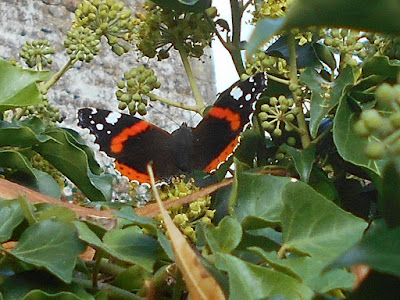Method 1 Use chopped up Cherry Laurel, Prunus laurocerasus, leaves, the vapour from which quickly kills off the aforementioned insects.
Method 2 Make use of a commercially produced fly spray.
Method 3 Requirements: a. two house bricks; b. a rapid arm movement.
Catch insect with the rapid arm movement and place on the first brick.
Bring second brick down firmly on the captive. Death is 100%.
(Likelihood of injured finger: >95%)
Method 4 Place some chopped up Amanita muscaria in a saucer of milk. The flies imbibe the milk and are stupefied.
I was reminded of Method 4 earlier today when out walking with Chris and friends across Northampton Golf Club's course just outside the picturesque Northamptonshire village of Harlestone. The acid soil is studded with birch trees and beneath the trees we found these specimens of the Amanita. It is known as Fly Agaric and its use for killing flies is well-documented; the specific name muscaria refers to this and is derived from the Latin musca - a fly.
 |
Fly Agaric, Amanita muscaria. Harlestone, Northants.
29 September, 2017
|
Though found throughout Britain and much of the Northern Hemisphere it is less than common in Northamptonshire where the acid soils it seems to require are not widespread. It usually occurs beneath birches but other trees are sometimes involved. Its faint but pleasant smell is deceiving because, although deaths from its consumption are very rare, its hallucinogenic properties can lead to illness.
Apparently Lapps in the northern parts of Russia and Scandinavia noticed that reindeer behaved oddly after consuming this fungus. (Of course the reindeer, hallucinating, believed that they could fly and thereby pull Santa's sleigh!) The Lapps used it as a hallucinogen, swallowing - without chewing - the dried caps.
 |
| The fungi were beneath birch trees. |
It has been suggested that berserkers, the storm troops of the Vikings, would consume Fly Agaric before going into battle. There is little evidence to back up this idea but it is possible since the drug causes extreme stimulation of the nerves so that: 'the slightest effort of will [produces] exaggerated physical effects so that, e.g. the intoxicated person will make a gigantic leap to clear the slightest obstacle'. (Philips, R, 1981) There are several other species of Amanita found in Britain (Buczacki et al, 2012), all to some extent poisonous or with hallucinogenic properties but the Fly Agaric is not only one of the commonest species but, unless the cap has faded, one of the most recognisable.
The Fly Agaric should not be confused with 'Magic Mushrooms'. These are species of Psilocybe, in particular the rather common P. semilanceata, found on lawns, roadside verges and so on.
References
Buczacki, S, Shields, C, and Ovenden, D. (2012) Collins Fungi Guide. Harper Collins
Philips, Roger (1981) Mushrooms and other fungi of Great Britain and Europe. Pan Books
The Fly Agaric should not be confused with 'Magic Mushrooms'. These are species of Psilocybe, in particular the rather common P. semilanceata, found on lawns, roadside verges and so on.
References
Buczacki, S, Shields, C, and Ovenden, D. (2012) Collins Fungi Guide. Harper Collins
Philips, Roger (1981) Mushrooms and other fungi of Great Britain and Europe. Pan Books













































